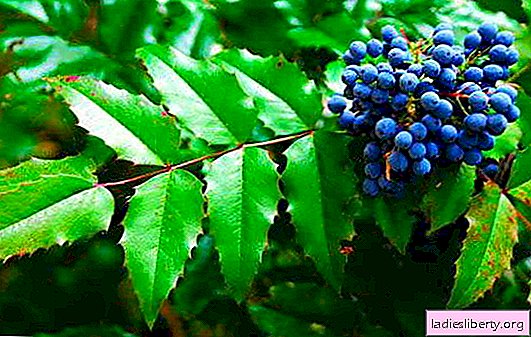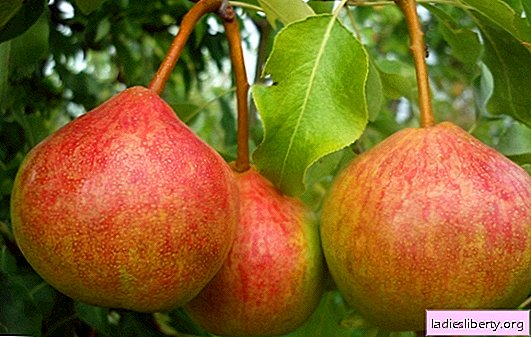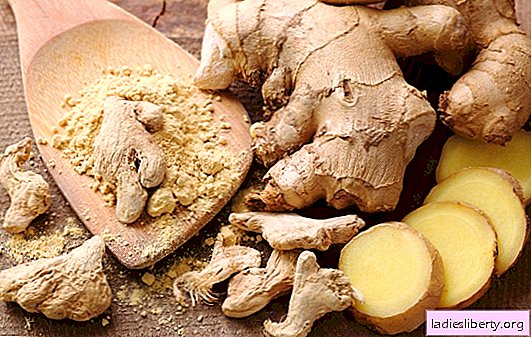
By planting evergreen shrub magonia holly on its plots or in the yards, several goals can be achieved.
Firstly, it can become a hedge, albeit not very high.
Secondly, its bright flowers and leaves that do not fall even in winter enliven any garden and delight the eye.
Thirdly, it gives a crop of berries suitable for consumption in a fresh and canned form.
What kind of plant is this, what is the care for the holly magonia, the photo of which you can see here.

Magonium border

Berries of mahonia
Description of the hollow magonia
The first word from the name of this shrub came from the surname of the American botanist and gardener Bernard McMahon, who lived in the 18th century. The American garden calendar, released in circulation in 1806, brought worldwide fame to the scientist. Already in 1818, the botanist Thomas Nutall gave the name "mahonia" to the newly described genus of the barberry family from western North America. In the genus of magonium, there are more than 50 species of plants, but the most common is magonia holly. The second word from the name appeared due to the similarity of leaves of mahonia with leathery leaves of holly, or holly.
A bush of mahogany rarely exceeds a height of 1 m. A width of 1-1.5 m is usually supported by cropping. The plant is extremely prolific by root offspring, so their planting is quite dense and also require pruning. The leaves consist of 5-9 leathery shiny leaflets with sharp-toothed edges. The length of the leaves is up to 50 cm. Young leaves blooming in spring have a reddish hue, which changes to dark green closer to summer. In autumn, the entire bush "turns red" (the leaves acquire a bronze-red hue) and so it stands all winter. Fragrant inflorescences consist of small yellow flowers collected in large panicles. A bush usually blooms all May (in central Russia), but in a warm climate it can bloom again in October. Dark-blue berries ripen in August, have a sweet and sour taste, have healing properties and are suitable for use in cooking. The berries do not fall for a long time, they can remain on the bushes for 4-5 months. Breeders periodically develop new sweet-fruit varieties of mahonia.
Peculiarities of the cultivation of mahonia holly in different climatic zones
Holly paddy is a winter-hardy plant that can tolerate frosts of -30 ° C without loss, it can grow in any climate. The greatest harm to the bushes is caused by the change of thaws and severe frosts. In areas where such weather changes are frequent, and where there are frosty, snowless winters, partial or complete shelter of the bushes will be required. In central Russia, adult mahonia is not covered, and young can be covered with lapnik or special material. In the north, at the latitude of Arkhangelsk, it is desirable to cover adult bushes, or at least their root system.
In some warm regions, magonium blooms again in October. At the same time, flowering is delayed throughout the winter, and the fruits ripen by May. This shrubbery feels great in the Russian south - in the Caucasus and Crimea.
Holly Magonia: variety selection, planting
The most popular varieties of holonia magonia are the following:
Apollo. The variety was bred in Holland in 1973. The height and width of the bush is from 0.6 m to 1 m. It blooms in May, fragrant flowers up to 0.8 cm, the fruits are small, ripen in August. Leaves become bronze by winter. Slow-growing variety with abundant flowering.
Atropurpurea. Compact bushes with a crown diameter of 0.6 m. Dark green leaves up to 25 cm long. In autumn and winter, the leaves become purple.
Versicolor. The leaves in the warm season are green with orange, cream, pink spots, and in the winter - bronze-purple. The crown is spreading with a diameter of up to 1 m.
New varieties of hollow magonia begin to spread: Baby, Nataha, Mermaid and others. Of the large-fruited varieties, Blyumun and Blyuklaud stand out, the weight of the berries reaches 0.9 g.
Hybrid varieties are also bred. Thus, the crossbreeding of the hollow magonia with the common barberry gave us the Newbert magobarbaris. It is semi-evergreen, medium-sized leaves, up to 7 cm long. Simple leaves are related to magobarris with barberry, and the absence of thorns and the arrangement of leaves are associated with magonia. The usual height of the bush is up to 1 m.
Having chosen the appropriate variety, they begin to plant the mahonia. For its safe survival and good growth before planting, certain conditions should be observed:
Landing time - the beginning of spring, so that the root system has developed well before the cold. Magonia does not tolerate transplantation, so it is best to purchase seedlings with a closed root system.
A place - light or slightly shaded, windless.
The soil - rich in nutrients, fertile, light, neutral or slightly acidic. Digging the soil before planting is mandatory, since mahonia loves loose soil. With heavy soil, make drainage from crushed stone, coarse pebbles in the planting pit. It is advisable to add humus, sand, turf soil to the ground.
Distance - for single free landings - 2 m, and for group (borders) - about 1 m.
Landing depth 40-50 cm, the root neck is not instilled, it should be at ground level.
Keep in mind that in order to get berries you need to plant at least 2-3 bushes, since mahonia is a non-self-pollinating plant.
Holly Magonia: care (photo)
Throughout the life of the hollow magonia, she needs care (photos are attached). Care is not difficult, mahonia is considered an unpretentious plant.
• Loosening, weeding, removing weeds and unnecessary young growth. Digging under the bush is not needed, only mulching the trunk circle. In the photo - magonia holly, care in the form of mulching the soil.
• Pruning. The bush does not grow more than 0.6-1 m, so pruning is carried out not to control the height, but to give shape. Bushes are quickly restored. Pruning is carried out after flowering, that is, in May-June. If the next abundant flowering of the bush is important to you, then try to keep the shoots with nascent flower buds. You can trim the shoots to no more than 1/2, and preferably 1/3 of the length. In old bushes aged 15 years and more, anti-aging pruning is performed “on the stump” when all branches and shoots are cut close to ground level.
• Breeding. Holly paddy can be propagated by green or root cuttings, roots (young shoots) or layering and seeds. The most time-consuming method is seed propagation. Most of all, success is guaranteed by the planting of mahonia from the root shoot, which is usually quite a lot.
• Watering. Magonia tolerates short-term drought more easily than heavy irrigation or rain. In hot weather, once a week, a bush is watered with 10 liters of water, preventing its stagnation. In dry weather, watering is necessary not only to the roots, but also to the dense leaves of mahonia. Water from a watering can or a hose with a spray will wash away the accumulated dust and clean the pores on the leaves. Top dressing. Before flowering, NPK is fed, that is, any complex fertilizer, which includes phosphorus, nitrogen and potassium, 90-120 g / m2.
• Winter preparations. In regions with severe winters, it is necessary to cover the bushes for the winter with spruce branches or covering material. Young bushes need shelter and in the middle lane.

Holly Magonia: pests and diseases
Above, we talked about the peculiarities of the holony mahonia, caring for it, and the photos are designed to facilitate the perception of information. Now it is time to say a few words about its pests and diseases and how to deal with them.
Magonia is resistant to pests, but in adverse seasons, especially during the cool rainy summer, it can suffer from powdery mildew (white bloom), spotting and rust (yellow tubercles under the leaves).
If rust is found on single leaves, the leaves or shoots must be cut off as quickly as possible, then in 1-2 seasons the bush density will be restored due to the appearance of young shoots. The bush is treated with a sulfur-containing preparation or Tsineb fungicide or the like.
At the first signs of powdery mildew on leaves, flowers or fruits, the plant should be treated with special preparations. If adverse weather conditions persist, it is worth continuing treatment every 10-14 days with these drugs, for example, Fundazole or toxin-M fungicide.
Bordeaux fluid, polycarbacin, or copper-containing preparations help with spotting. You can dilute in 10 l of water 200 g of soap and 20 g of copper sulphate and spray the bushes with this mixture.

Powdery mildew











